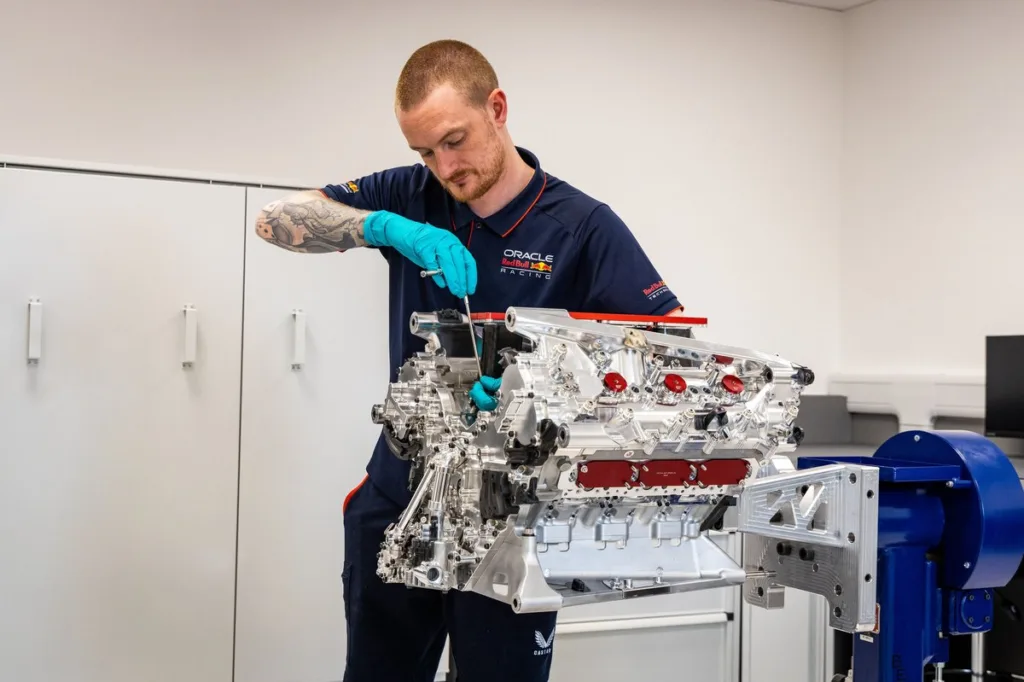Formula 1 News: Exclusive Look into Red Bull’s 2026 Engine Project at Milton Keynes Facility
On Tuesday, a select group of media were granted access to the Jochen Rindt building at the Red Bull Campus in Milton Keynes, where Red Bull Powertrains and Ford are working together to develop Red Bull’s own engine project for the 2026 Formula 1 season.
In 2026, both engine and chassis regulations will undergo significant changes. The MGU-H will be removed, and the percentage of electric power will increase to almost a 50-50 split with the internal combustion engine. The V6 engine will also be required to run on sustainable fuels.
Red Bull’s decision to create its own engines marks a significant shift, as Honda will be leaving as its engine partner in 2026. Currently, all Red Bull Racing and RB engines are produced in Japan, but with Honda joining forces with Aston Martin, Red Bull has taken its fate into its own hands.
As part of this project, Red Bull Powertrains offered a rare behind-the-scenes look at its facility. The day began with a reception in MK7, where many Red Bull cars from previous F1 seasons are on display. Christian Horner, Red Bull Racing Team Principal, and Mark Rushbrook, Ford Motorsports chief, explained that work on the building started early in 2022.
Work on the internal combustion engine (ICE) section began first, followed by the electrical component (ERS) department early this year. The ERS department will become even more crucial under the 2026 regulations.
After a brief tour, we were led to ‘Brodie’s Boulevard’, named after Steve Brodie, one of the first employees to join from Mercedes HPP in August 2021. Brodie played a vital role in setting up the Powertrains facility and is responsible for ensuring that Red Bull-Ford engines are built to the correct specifications, standards, and consistency.
One of the engines was on display, with Horner explaining that it was the first combustion engine they made, which fired up in August 2022. Dietrich Mateschitz, Red Bull’s late founder, was able to hear the engine before his passing, and Red Bull has since labeled all its engines as DM in his honor.
The engine on display also played a crucial role in convincing Ford to join the project when negotiations with Porsche broke down. Rushbrook explained that Ford’s contribution will go beyond just the electrical parts of the 2026 engine, as they will also contribute to the turbocharger and testing rigs for the combustion engine.
The tour continued through the engine store, cleaning area, and build shop, where the internal combustion engines are assembled. The assembly area resembled a laboratory, with one half dedicated to a V6 engine and the other to a single cylinder, used to make development more efficient.
When it comes to testing, Brodie handed over to Florian Niehaves, who led us to a room reminiscent of mission control. This is the hub for multiple testing rigs of individual engine components before they go onto the full power unit.
Red Bull Powertrains indicated that it is close to the limit of what is allowed in terms of equipment, with the infrastructure in place capable of supplying a total of four F1 teams with engines.
While Red Bull’s focus is currently on its two teams, Horner acknowledged that they have been approached by other teams interested in their engine supply. However, he emphasized that financial rules for engine supplies need to change, as supplying an engine to a customer is currently a loss-making exercise based on the FIA pricing.
After the tour, Horner took us to the design offices, where screens were filled with figures and design sketches. While taking photos was strictly forbidden, it was clear that Red Bull’s engine project is a significant undertaking.
As the Red Bull Campus continues to grow, the in-house engine project marks the latest step in the team’s evolution. By integrating the engine and chassis departments, Red Bull aims to no longer be dependent on an engine supplier and to gain a competitive edge in the 2026 season.
Whether the engine will be competitive remains to be seen, but Red Bull’s commitment to its project is clear. As Rushbrook put it, their motto should be “under-promise and over-deliver.”
🔗 Source
